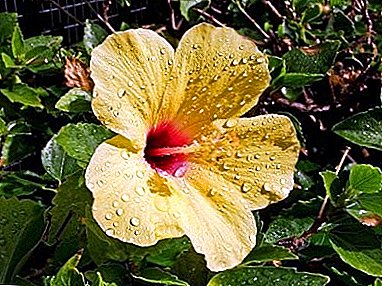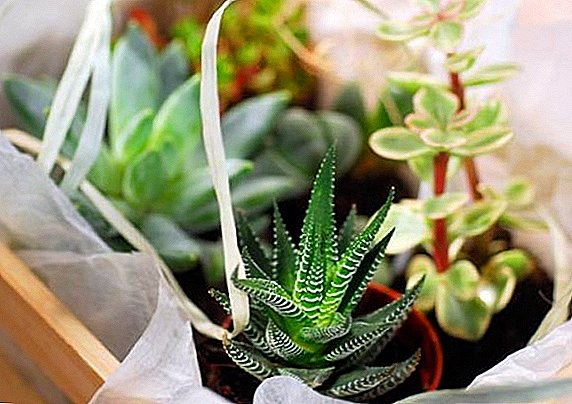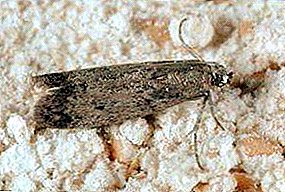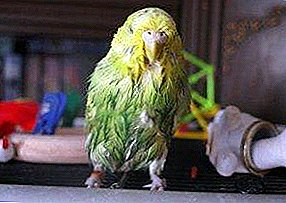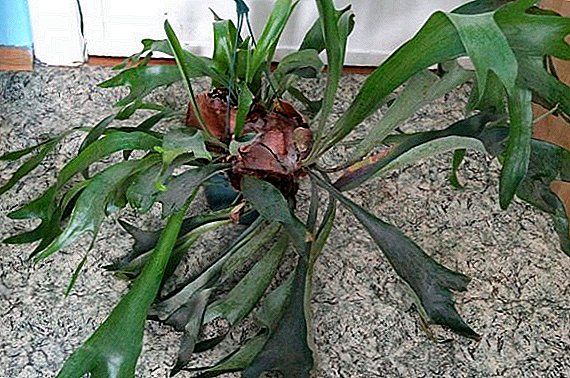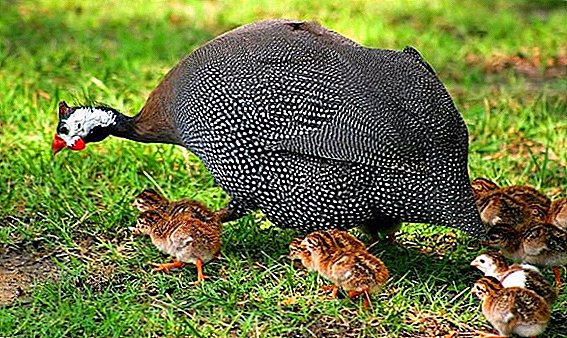 Guinea fowls are very common in warm countries, where they are bred in mountainous regions with open meadows or else in steppes with a high herbage. But despite the fact that guinea fowls are accustomed to warm latitudes of habitat, they are very well accustomed to a colder climate, where their cultivation will not be difficult. Therefore, let us consider in more detail the fowl - what kind of bird is it and how to grow it properly at home.
Guinea fowls are very common in warm countries, where they are bred in mountainous regions with open meadows or else in steppes with a high herbage. But despite the fact that guinea fowls are accustomed to warm latitudes of habitat, they are very well accustomed to a colder climate, where their cultivation will not be difficult. Therefore, let us consider in more detail the fowl - what kind of bird is it and how to grow it properly at home.
Why bred at home
At home, hen bred for:
- decorative purposes to decorate a country estate or cottage;
- obtaining eggs, which are considered to be hypoallergenic, highly valued by consumers, rich in vitamins and trace elements, are quite expensive on the market;
- eating meat - the bird grows more chicken, and its meat is rich in hemoglobin.
- sales of bird feathers as decoration or raw material for the manufacture of exclusive decorative items.
 With proper storage, the shelf life of guinea fowl eggs is one year, which is very beneficial if you breed a bird for the purpose of selling eggs.
With proper storage, the shelf life of guinea fowl eggs is one year, which is very beneficial if you breed a bird for the purpose of selling eggs.Did you know? The first information about guinea fowls appeared thanks to the ancient Greeks, who depicted these birds in mosaics. Africa is considered the birthplace of this bird, from where it was once brought to Ancient Rome and Ancient Greece.
How to choose healthy adults when buying
What should a beginner do to properly breed guinea fowls? First of all, it is necessary to choose the right individuals so that in the future there will be no problems with their cultivation. It is necessary to clarify that for breeding at home are suitable only homemade gray guinea fowl, despite the fact that there are only 25 species in nature.
It is necessary to acquire individuals in a specialized poultry farm, which will be a guarantee of poultry origin, health and productivity. During the purchase it is necessary to ask and carefully read the veterinary certificate, which will contain the necessary information about the purchased product.  For the purchase of guinea fowls suitable individuals, starting from the daily age. It is during this period that transportation will be less painful for the bird. If you buy older guinea fowls, then during transportation there will be a need for a special container. Sometimes, if transportation is long, the birds are provided with food and water. But despite the difficulties with transportation, such a bird will be easier and faster to grow.
For the purchase of guinea fowls suitable individuals, starting from the daily age. It is during this period that transportation will be less painful for the bird. If you buy older guinea fowls, then during transportation there will be a need for a special container. Sometimes, if transportation is long, the birds are provided with food and water. But despite the difficulties with transportation, such a bird will be easier and faster to grow.
Adults are not recommended for purchase.
Important! When buying it is necessary to take into account that a small group of birds will be worse preserved and slower to develop, therefore it is recommended to acquire at least 20 heads at once.
In order to choose good healthy guinea fowlneed to pay attention to following features:
- The bird should be well-fed, not limp, have no body builds, have a typical color.
- You can not buy birds that have signs of rickets, for example, curvature in the chest bone or wings, emaciated individuals, which are a violation of the coordination of movement, as well as swollen belly.
- At 5 months of age (in this period you can certainly determine the sex of guinea fowl), the average bird weight should be: for females - at least 1.3 kg, for males - 1.4 kg.
- The bird should be with bulging, shiny, moving eyes. Pay attention to the pupil - it should not be reduced and slit-like.

To understand how to distinguish guinea fowls, namely male from female, should be considered such features:
- Birds at 5 months of age differ in size and shape of head appendages. Females have a small and flat bluet, which practically does not rise above the beak. Males, on the other hand, have a larger and arcuate ceramum, which rises above the beak and has a brighter color than that of females.
- On the head, the males have a large, upright ridge, while the females, on the contrary, have a small crest and are directed backwards.
- Males also have side earrings, which are sometimes twisted and larger in size than those of females.
Important! When selecting males, it should be borne in mind that there should be 4-5 females per 1 males, and in a group there should not be less than 2-3 males.
Room arrangement for guinea fowls
For breeding guinea fowls, it is necessary to arrange the premises where they will be located. This will require an economic structure that will be sufficiently insulated and without drafts.  The room must be conveniently equipped place for laying eggs. In order for females to rush better, it is necessary to provide a litter in a room that would absorb moisture well and warm it.
The room must be conveniently equipped place for laying eggs. In order for females to rush better, it is necessary to provide a litter in a room that would absorb moisture well and warm it.
The floor is treated with slaked lime, for this it is necessary to use about 1 kg of product per 1 square meter. m. Only after this manipulation on the floor lay dry litter. For these purposes, straw, dried grass, sawdust is used. Also, females should arrange perches that will be 50 cm above the floor. The length of the perch should be at least 1 m for 5 individuals.
For its magnificent view and gorgeous tail the peacock received the name "bird of paradise". We advise you to read how to maintain and feed the handsome man at home.
Aviary for walking
Guinea fowl are very fond of free space and plenty of space for walks, so you need to equip a large aviary. It is especially important to provide walking in a spacious open-air cage during the mating season, because mating will not occur in the cramped space.  An open-air cage in which birds will walk should be covered with a net up to 2 m high, since they can fly over the enclosure if it is below this height.
An open-air cage in which birds will walk should be covered with a net up to 2 m high, since they can fly over the enclosure if it is below this height.
Also, in order to protect the bird from the scorching sun or to protect from rain, it is recommended to make a canopy.
Learn how to breed exotic birds such as pheasants and ostriches at home.
Feeding ration
Consider what it costs to feed guinea fowls when breeding at home. This bird is perfect picky about food and can eat carrots, beets, potatoes, food waste, fresh grass in shredded form, and guinea fowls can feed on feed that are intended for chickens. Fresh green birds should be provided from the calculation: each individual - at least 50 g per day. The amount of the main feed should be up to 150 g.
Important! Eggs bred in water will contribute to raising egg production.
Guinea fowls, when they begin to lay eggs, it is necessary to provide calcium-containing feed, or to make additional feeding in the form of crushed eggshell.  Birds also eat worms, snails and some insects, which fully satisfy their needs in animal feed. If their walking is restricted to an open-air cage, you should regularly supplement the diet with fish waste in boiled form or chopped boiled meat.
Birds also eat worms, snails and some insects, which fully satisfy their needs in animal feed. If their walking is restricted to an open-air cage, you should regularly supplement the diet with fish waste in boiled form or chopped boiled meat.
Guinea fowls very well destroy the Colorado beetles and do not harm the crop. But the cabbage to let them out of these birds is not worth it, because they can peck heads.
It is necessary to feed guinea fowl 3 times a day: in the morning, at lunch and in the evening. During feeding birds need to provide them with fresh and cold water, and if it is a cold season, the water should be at room temperature.
If you have purchased small chicken, you must bear in mind that their diet is slightly different from the nutrition of adults.
For young stock, it is necessary to ensure that the protein content in the feed is about 25%, and at an older age, the protein should be about 15-20%. Guinea fowl need to provide green succulent feed. When the chicks are one week old, you can cut up young fresh grass, for example, clover, alfalfa, wild cereals, cabbage and dandelion.  The diet should be varied, that is, contain both greens and specialized feed, as well as feed wheat, corn, millet groats, and, if possible, dried milk and fresh cottage cheese. It is also necessary to provide the ration with crushed chalk, crushed shell, coarse-grained and well-washed river sand, as well as boiled, chopped eggshell.
The diet should be varied, that is, contain both greens and specialized feed, as well as feed wheat, corn, millet groats, and, if possible, dried milk and fresh cottage cheese. It is also necessary to provide the ration with crushed chalk, crushed shell, coarse-grained and well-washed river sand, as well as boiled, chopped eggshell.
In ancient times, pigeons were sometimes the only means of communication, but now these birds are bred for decorative, sports and culinary purposes. When dealing with pigeons, we should not forget about the dangerous diseases that they suffer.
Peculiarities of guinea fowl maintenance in winter
In winter, guinea fowls should be in dry and warm roomwhose air temperature does not fall below 18 ° C. It is necessary to clean the room once a month, changing the old litter to fresh, as it becomes dirty. Also, birds must be provided with fresh air, for this you can do ventilation in the upper part of the wall.
Guinea fowls need long and good illumination, for this the switched on light must be at least 12 hours a day. In winter, guinea fowls can also be taken out for a walk if the air temperature does not fall below -10 ° C. Walking should be carried out for a limited time, or else to monitor the behavior of birds: if they are knocked together, this is a sign that they are freezing, and they should be returned to the premises.  The winter diet of guinea fowls should be complete, and feeding should be carried out 2 times a day. In the morning you can give mash, which will contain meat waste with sour milk and special tools that increase egg production. In the evening it is necessary to provide the bird with grain and animal feed.
The winter diet of guinea fowls should be complete, and feeding should be carried out 2 times a day. In the morning you can give mash, which will contain meat waste with sour milk and special tools that increase egg production. In the evening it is necessary to provide the bird with grain and animal feed.
There should be constant feeders in the room, which will contain shell, chalk, very fine gravel. You should also equip another box where ashes and sand fall asleep in a 1: 1 ratio so that guinea fowls can bathe in this mixture.
Read also about breeding and quail breeds.
Can I keep with chickens
In the case of guinea fowls with chickens there are several options for the development of events.
In the first version, chickens and guinea fowl can both get along and not get along together. In order to determine what will come of it, it is recommended that several individuals be hooked into the chicken coop and see how they will behave, and whether the roosters will attack the guinea fowls.  It is also possible to simply start growing young chickens and guinea fowls together, under this condition, they will get along better. In this case, after they grow up, there will be some advantages from such a tandem, for example, there is no need to provide a separate room.
It is also possible to simply start growing young chickens and guinea fowls together, under this condition, they will get along better. In this case, after they grow up, there will be some advantages from such a tandem, for example, there is no need to provide a separate room.
But the main advantage of keeping these birds together is the incubation of eggs. Due to the fact that guinea fowls are prone to poor incubation and are considered not very responsible mothers, chickens may begin to hatch their eggs, which greatly increases the possibility of fertilization.
Did you know? For consumption, the meat of the guinea fowl in the Soviet Union was used only in 1945, despite the fact that it was started to be bred on this territory in the 18th century, for decorative purposes.
There is another option. It may happen that during the mating season, roosters will pay attention to the female fowl. In this case, it may turn out to be either a strange mixture of guinea fowl and chicken after receiving offspring, or the eggs simply cannot be fertilized. Therefore, in this case, it is necessary to separate the guinea fowl and chickens separately during the mating season in order to prevent the appearance of undesirable mixed offspring.
The "relative" of the turkey, peacock and guinea fowl is a partridge, which can also be bred at home.
Rearing
In order to get the eggs out of the eggs, you need to use eggs that were stored no more than a week in a dark place and at a temperature of 2 to 6 ° C, and the humidity was between 70-80%. Also, the eggs should be laid in special cells, blunt end up.  Before laying the eggs in the incubator or under the hen, they must be carefully sorted and looked into the light in a dark room. For incubation, suitable eggs that have a mass of not less than 40 g, without cracks of the shell, the correct pear shape. Very large or vice versa small eggs, irregularly shaped, which have been stored for a long time, or have two yolks, should not be laid in the incubator.
Before laying the eggs in the incubator or under the hen, they must be carefully sorted and looked into the light in a dark room. For incubation, suitable eggs that have a mass of not less than 40 g, without cracks of the shell, the correct pear shape. Very large or vice versa small eggs, irregularly shaped, which have been stored for a long time, or have two yolks, should not be laid in the incubator.
- The first week of incubation should be carried out at a temperature of 37.8 ° C and a humidity of 50%, the eggs should be rotated 4 times a day.
- From the end of the first week to the second, the temperature should be the same, and the humidity should be reduced by 5% to 45%. Turning eggs should be carried out 6 times a day.
- From the 15th to the 18th day, the air temperature should be 37.8 ° С, and the humidity - 50%. At the same time, it is necessary to turn the eggs 6 times a day, and you should also cool the eggs twice a day for 20 minutes.
- From the 19th to the 25th day, the air temperature should be 37.5 ° С, and the humidity should be 65%.
- On the 26th day you need to transfer the eggs to the hatcher chambers. Guinea fowl are hatching eggs quickly and at the same time. Typically, mass withdrawal begins after a few hours after you transfer the trays of eggs to the hatcher chambers.
 After the royal chickens fluff and dry, they should be removed from the incubator and transplanted into boxes adapted for daily young, 25 individuals each.
After the royal chickens fluff and dry, they should be removed from the incubator and transplanted into boxes adapted for daily young, 25 individuals each.Important! When growing chickens under the hen, often up to 20 eggs can be laid under a chicken or turkey. In this case, you must be sure of the hen and be selected for maternal qualities and previous incubations.
On the first day of hatching chickens, it is necessary to irradiate a quartz lamp for 2 minutes. Through this procedure, young animals will increase hatchability and improve health.
In the first 3 days of life, the Caesarean are almost always under the heater or under the hen, they are inactive and lie with their eyes closed.
Brood grows fast enough and after a month begins to fledge. Up to 3 months of age, guinea fowls are already fully fledged and differ from adults only in smaller sizes, and also they lack a crest on the head. At this age, individuals reach a weight of 1 kg.
Thus, it is not difficult to breed and maintain guinea fowls at home, the main thing is to follow the recommendations and advice on the care, feeding and proper keeping of poultry.




